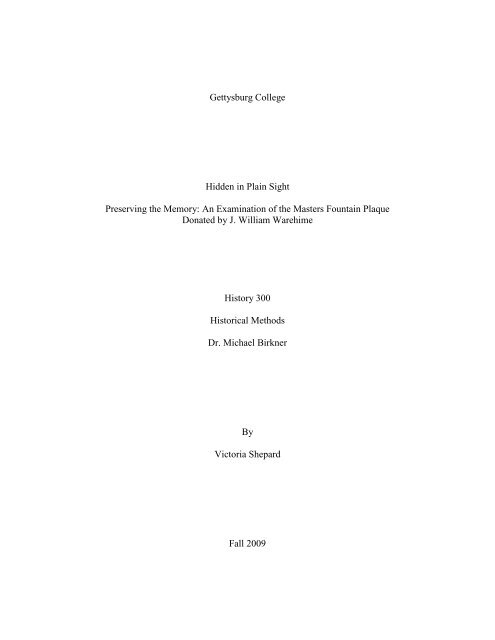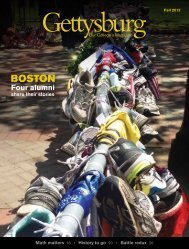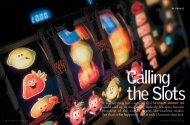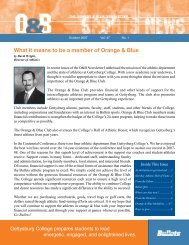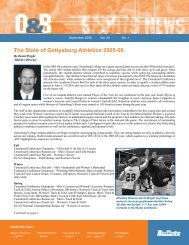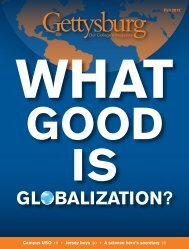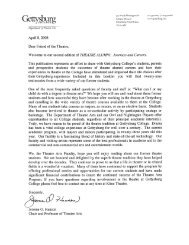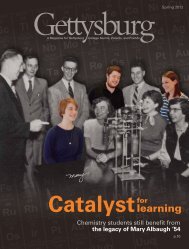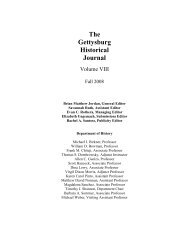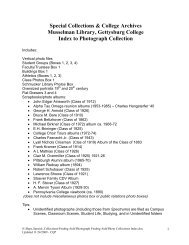An Examination of the Masters Fountain Plaque Donated by J. Wil
An Examination of the Masters Fountain Plaque Donated by J. Wil
An Examination of the Masters Fountain Plaque Donated by J. Wil
Create successful ePaper yourself
Turn your PDF publications into a flip-book with our unique Google optimized e-Paper software.
Gettysburg College<br />
Hidden in Plain Sight<br />
Preserving <strong>the</strong> Memory: <strong>An</strong> <strong>Examination</strong> <strong>of</strong> <strong>the</strong> <strong>Masters</strong> <strong>Fountain</strong> <strong>Plaque</strong><br />
<strong>Donated</strong> <strong>by</strong> J. <strong>Wil</strong>liam Warehime<br />
History 300<br />
Historical Methods<br />
Dr. Michael Birkner<br />
By<br />
Victoria Shepard<br />
Fall 2009
Shepard 2<br />
It is crucial not to underestimate your surroundings, for every place embraces a story. My story unfolds<br />
two years ago during a perfect day in late summer <strong>of</strong> 2007, a day to witness <strong>the</strong> beauty <strong>of</strong> Gettysburg College<br />
at its prime. Merely a skittish freshman, I remember walking hurriedly to my first Astronomy class in <strong>Masters</strong><br />
Hall while simultaneously attempting to soak in <strong>the</strong> pristine condition <strong>of</strong> <strong>the</strong> surrounding brick buildings and<br />
picturesque landscape. I could not help but feel intimidated <strong>by</strong> <strong>the</strong> upperclassmen, already accustomed to <strong>the</strong><br />
Gettysburg lifestyle. Quickening my pace, I finally reached <strong>Masters</strong> Hall and paused before <strong>the</strong> massive,<br />
elaborate brick structure just before its entrance. The fountain was not operating and I remember wondering<br />
why and what it would look like if it were. As I moved closer and peered inside, soapsuds blanketed <strong>the</strong><br />
water‟s surface. It was a humbling moment for me, <strong>the</strong> perfect welcome to my Gettysburg College experience.<br />
It was one that made me realize that aside from <strong>the</strong> serious education I knew that would undoubtedly receive, it<br />
was not quite time to grow up. As a person with a valued appreciation for aes<strong>the</strong>tics, <strong>the</strong> sights and sounds <strong>of</strong><br />
<strong>the</strong> <strong>Masters</strong> fountain have always provided tranquility, even in <strong>the</strong> most stressful situations. Whe<strong>the</strong>r it is <strong>the</strong><br />
scene for a harmless prank, <strong>the</strong> location <strong>of</strong> a midnight swim (for all <strong>of</strong> <strong>the</strong> doubters, one <strong>of</strong> my sorority sisters<br />
has in fact jumped into <strong>the</strong> fountain), a place to meet, or simply an object <strong>of</strong> visual appeal, <strong>the</strong> Master‟s<br />
fountain is an essential landmark on <strong>the</strong> Gettysburg campus.<br />
There is ano<strong>the</strong>r element <strong>of</strong> this fountain, however, that remains hidden in plain sight. I am quite<br />
certain that it is typically unnoticed because I, and those I have asked, have never realized its presence unless<br />
purposefully searching for it. On <strong>the</strong> far side <strong>of</strong> <strong>the</strong> fountain from <strong>the</strong> entrance <strong>of</strong> <strong>Masters</strong> Hall sits a plaque.<br />
The benefactor placed a fountain on our college campus with a purpose, to preserve an aspect <strong>of</strong> his or her life<br />
in order for it to be shared with <strong>the</strong> greater community for years to come. The plaque describes this purpose,<br />
and <strong>the</strong>se are <strong>the</strong> words inscribed upon it:<br />
Given <strong>by</strong> J. WILLIAM WAREHIME in memory <strong>of</strong><br />
FRIENDS and CLASSMATES <strong>of</strong> 1950<br />
CHARLES A MUSSELMAN<br />
JAMES K. LONG<br />
J. CALVIN LANG<br />
PHILLIP H. WALTERSDORF
Shepard 3<br />
Viewing <strong>the</strong> plaque for <strong>the</strong> first time caused a multitude <strong>of</strong> questions to arise that can be summarized <strong>by</strong><br />
writing tools we learned back in grade school: Who were <strong>the</strong> people mentioned on this plaque? What is <strong>the</strong>ir<br />
importance? Where are <strong>the</strong>y now? When was <strong>the</strong> fountain installed? <strong>An</strong>d why did <strong>the</strong> donor choose to erect a<br />
fountain to commemorate <strong>the</strong> memory <strong>of</strong> his college experience? I began my search in special collections.<br />
With <strong>the</strong> help <strong>of</strong> preserved Gettysburg College publications such as <strong>the</strong> Spectrum, <strong>the</strong> Alumni Bulletin,<br />
and <strong>the</strong> Gettysburgian, I was able to uncover some answers to my countless inquiries. The “<strong>Masters</strong> <strong>Fountain</strong>”<br />
was a component <strong>of</strong> a dynamic transformation encompassing <strong>the</strong> entire campus during <strong>the</strong> summer <strong>of</strong> 1991.<br />
Renovating and modernizing aspects <strong>of</strong> <strong>the</strong> school became a sort <strong>of</strong> summer tradition that began in 1986 and<br />
continued during <strong>the</strong> subsequent summers. As Jerold Wik<strong>of</strong>f writes in <strong>the</strong> winter 1992 edition <strong>of</strong> <strong>the</strong> Alumni<br />
Bulletin, “Those who left <strong>the</strong> college in May 1991 almost didn‟t recognize <strong>the</strong> campus when <strong>the</strong>y returned this<br />
past autumn.” 1 The new face <strong>of</strong> Gettysburg included: a complete renovation <strong>of</strong> <strong>the</strong> College Union Building,<br />
rooms for student activities in Plank Gym, <strong>the</strong> relocation <strong>of</strong> railroad tracks from <strong>the</strong> center <strong>of</strong> campus to <strong>the</strong><br />
western perimeter, and <strong>the</strong> creation <strong>of</strong> <strong>the</strong> Ice House Apartment Complex. In addition to <strong>the</strong> renovations that<br />
launched <strong>the</strong> campus into <strong>the</strong> modern era as we view it today, <strong>Masters</strong> Hall was also reconstructed into an<br />
attractive structure, with two new towers and a distinctive entrance complete with a remarkable fountain, “A<br />
new fountain, donated <strong>by</strong> J. <strong>Wil</strong>liam Warehime ‟50 in memory <strong>of</strong> his four friends from <strong>the</strong> class <strong>of</strong> 1950 . . .<br />
graced outside <strong>the</strong> entrance to <strong>Masters</strong>, providing an ideal meeting place for students.” 2 The fountain is<br />
between 24 and 26 feet wide and is encircled <strong>by</strong> a raised sitting wall led to <strong>by</strong> a small step. 3 It contains ten<br />
spouts <strong>of</strong> water and an impressive sensory device that sits atop <strong>of</strong> Plank Gym and suspends <strong>the</strong> flow <strong>of</strong> water<br />
when <strong>the</strong> wind reaches a certain velocity. 4 Measurements and facts only provide us with a one-dimensional<br />
view to <strong>the</strong> fountain‟s existence on Gettysburg campus. To truly understand <strong>the</strong> reasoning for its installation<br />
1 Jerold Wik<strong>of</strong>f, “The Changing Face <strong>of</strong> Gettysburg College,” Gettysburg College Bulletin: Alumni Issue, Winter 1992, 20.<br />
2 Ibid, 21.<br />
3 <strong>An</strong>n Marie Schropp, “Renovations on Campus to Include a 26-foot <strong>Fountain</strong>,” Gettysburgian, April 25, 1991.<br />
4 Victoria Shepard interview with Jean LeGros, September 23, 2009.
Shepard 4<br />
and more importantly, <strong>the</strong> underlying meaning <strong>of</strong> <strong>the</strong> plaque upon it, <strong>the</strong> investigation must continue with <strong>the</strong><br />
life <strong>of</strong> J. <strong>Wil</strong>liam Warehime.<br />
I was disheartened to learn that Mr. John <strong>Wil</strong>liam Warehime, also known as Bill, past away on<br />
Thursday, January 10, 2008 at his home due to health related issues, specifically Parkinson‟s disease. 5<br />
Although he seemed like a delightful character that I would have enjoyed getting acquainted with, I had <strong>the</strong><br />
pleasure <strong>of</strong> meeting with a few people who knew him personally, most <strong>of</strong> whom described him as “eccentric,<br />
with a tremendously big heart.” 6 J. <strong>Wil</strong>liam Warehime was born on June 8, 1927, <strong>the</strong> son <strong>of</strong> Harry and Alice,<br />
who in 1924 founded <strong>the</strong> Hanover Canning Company. This business would later become <strong>the</strong> Hanover Foods<br />
Corporation, <strong>the</strong> largest independent food processor in <strong>the</strong> United States. Warehime graduated from<br />
Eichelberger High School as <strong>the</strong> president <strong>of</strong> his graduating class in 1945. He joined <strong>the</strong> U.S. Army, but never<br />
entered into combat as World War II was over at this time, and was honorably discharged in 1946. This<br />
prompted his decision to enroll into Gettysburg College in 1947, when it is estimated that around 500 students<br />
attended. 7 While in college he majored in business administration, still <strong>of</strong>fered at that time, although he<br />
admitted to not being <strong>the</strong> best student. 8 Active in o<strong>the</strong>r organizations such as <strong>the</strong> Gettysburgian circulation<br />
staff, Warehime was elected into <strong>the</strong> Phi Lambda Sigma national honorary and pre-legal fraternity as well as<br />
becoming a member <strong>of</strong> <strong>the</strong> Alpha Tau Omega fraternity along with three <strong>of</strong> <strong>the</strong> men mentioned on <strong>the</strong> <strong>Masters</strong><br />
<strong>Fountain</strong> plaque. 9 I was fortunate enough to meet with Mr. Warehime‟s Gettysburg roommate, fellow ATO<br />
bro<strong>the</strong>r, and best friend, Mr. Jerry Geiselman who currently resides in Hanover, Pennsylvania. As <strong>the</strong> best man<br />
at Mr. Geiselman‟s wedding, he and Mr. Warehime remained close throughout <strong>the</strong> many years after college<br />
until Mr. Warehime‟s death. Mr. Geiselman was able to <strong>of</strong>fer <strong>the</strong> more personal side <strong>of</strong> <strong>Wil</strong>liam Warehime‟s<br />
college years, relaying stories and describing him as having a “great sense <strong>of</strong> humor” with a fondness for<br />
5 Obituary <strong>of</strong> J. <strong>Wil</strong>liam Warehime, n.p., January 14, 2008, J. <strong>Wil</strong>liam Warehime file, Special Collections, Musselman Library.<br />
6 Victoria Shepard interview with Jean LeGros, September 23, 2009.<br />
7 Obituary <strong>of</strong> J. <strong>Wil</strong>liam Warehime, n.p., January 14, 2008.<br />
8 Victoria Shepard interview with Jean LeGros, September 23, 2009.<br />
9 Obituary <strong>of</strong> J. <strong>Wil</strong>liam Warehime, n.p., January 14, 2008.
Shepard 5<br />
pranks and playing bridge with his friends. 10 Bill Warehime never married or had children; however, Mrs. Jane<br />
Geiselman was nice enough to show me an old photograph <strong>of</strong> Mr. Warehime‟s one true love, a girl from New<br />
Jersey, whom he labeled as, “<strong>the</strong> girl that got away.” 11<br />
After graduating from Gettysburg in 1950, Bill Warehime joined <strong>the</strong> family business at Hanover<br />
Foods. He initially worked in <strong>the</strong> sales and purchasing department, but eventually advanced to <strong>the</strong> position <strong>of</strong><br />
secretary/treasurer as well as a member <strong>of</strong> <strong>the</strong> Board <strong>of</strong> Directors, before retiring in 1987. Afterward, he<br />
continued his work in ano<strong>the</strong>r family oriented business, Warehime Enterprises, a leasing and investing<br />
company. 12 In 1980, he also became a member <strong>of</strong> <strong>the</strong> Board <strong>of</strong> Directors at Snyder‟s Pretzels <strong>of</strong> Hanover,<br />
currently owned <strong>by</strong> Michael Warehime, <strong>the</strong> son <strong>of</strong> Bill Warehime‟s bro<strong>the</strong>r. Socially, Warehime was a lifelong<br />
member <strong>of</strong> <strong>the</strong> Hanover Arcadian Club among o<strong>the</strong>rs. As his obituary states, “he had been active in many<br />
community organizations and has given generously to local charities including his college, Gettysburg.” 13<br />
When speaking with Jerry Geiselman, it was apparent in his voice that he truly loved his alma mater and <strong>the</strong><br />
years he spent at college. I believe, without a doubt, that Bill Warehime felt <strong>the</strong> same way, and he expressed<br />
this connection through his many contributions to Gettysburg College. Ms. Jean LeGros, fellow Gettysburg<br />
alum <strong>of</strong> 1973 and <strong>the</strong> Associate Vice President for Alumni and Parent Relations Emertia, who worked with<br />
Mr. Warehime on several <strong>of</strong> his projects and was also a dear friend, put it simply, “he was fabulously wealthy<br />
and oozed „ornateness.‟” 14 I knew that <strong>the</strong> J. <strong>Wil</strong>liam Warehime story would not be complete without a brief<br />
exploration <strong>of</strong> <strong>the</strong> two additional gifts to <strong>the</strong> Gettysburg campus aside from <strong>the</strong> fountain as well as <strong>the</strong><br />
acclaimed Hanover Mansion.<br />
It initially took some convincing for <strong>the</strong> Gettysburg College administrators to allow Mr. <strong>Wil</strong>liam<br />
Warehime‟s funding to go towards installing stained glass windows into Glatfelter Lodge, a building <strong>of</strong>ten<br />
10 Victoria Shepard interview with Jerry and Jane Geiselman, September 28, 2009.<br />
11 Ibid.<br />
12 Obituary <strong>of</strong> J. <strong>Wil</strong>liam Warehime, n.p., January 14, 2008.<br />
13 Ibid.<br />
14 Victoria Shepard interview with Jean LeGros, September 23, 2009.
Shepard 6<br />
used for group meetings and informed events. However, despite this preliminary difficulty, Jean LeGros<br />
explains, “many people at <strong>the</strong> college appreciated <strong>the</strong>ir beauty after <strong>the</strong>y were constructed.” 15 She described his<br />
involvement in <strong>the</strong>ir production from 1992-1996 as very “hands on,” stating that he would <strong>of</strong>ten come to <strong>the</strong><br />
college to evaluate <strong>the</strong>ir progress as well as specifically decide on <strong>the</strong> color schemes and pieces <strong>of</strong> glass that<br />
would be used. The windows display a beautiful arrangement <strong>of</strong> floral landscape including <strong>the</strong> mountain laurel,<br />
<strong>the</strong> flower <strong>of</strong> Pennsylvania. One notable aspect <strong>of</strong> <strong>the</strong> Glatfelter Lodge windows is <strong>the</strong> discrete placements<br />
owls within every window. As a member <strong>of</strong> <strong>the</strong> Chi Omega chapter here at Gettysburg, along with Ms. Le<br />
Gros, it made me smile to see our sorority‟s symbol graced upon every pane. With a passion for collecting fine<br />
antiques such as “Wedgewood” china and grandfa<strong>the</strong>r clocks, most notable is Warehime‟s extravagant<br />
collection <strong>of</strong> owls. 16 Mr. and Mrs. Gieselman were able to expand on his love for this nocturnal creature and<br />
indicated its origins, “he would have hundreds <strong>of</strong> owl figurines lying around his house . . . His fascination<br />
started when an owl flew down his chimney and became trapped in his basement.” 17 The stained glass<br />
windows <strong>of</strong> <strong>the</strong> Glatfelter Lodge are stunning additions to <strong>the</strong> Gettysburg campus. If one has <strong>the</strong> time, <strong>the</strong>y<br />
should be carefully examined and appreciated.<br />
The last gift that Mr. Warehime donated to Gettysburg College towards <strong>the</strong> end <strong>of</strong> his life beautifies<br />
<strong>the</strong> campus <strong>by</strong> sight and sound. A magnificent carillon, which sits adjacent to <strong>the</strong> Quarry Suites on <strong>the</strong> west<br />
end <strong>of</strong> campus, measures at 50 feet and contains 23 bells that can be programmed to play various songs such as<br />
Gettysburg‟s alma mater. Built <strong>by</strong> <strong>the</strong> Verdin Co. in Cincinnati, Ohio, Bill Warehime was inspired to donate a<br />
carillon after he heard one play at his frequented summer retreat <strong>of</strong> Ocean City, New Jersey. 18 The plan to<br />
implement this generous gift on <strong>the</strong> campus was a joint effort <strong>by</strong> a board that consisted <strong>of</strong> college<br />
administrators and students. “The committee figured out where it would go and when during <strong>the</strong> day it would<br />
15 Ibid.<br />
16 Ibid.<br />
17 Victoria Shepard interview with Jerry and Jane Geiselman, September 28, 2009.<br />
18 Ibid, 1.
Shepard 7<br />
play.” 19 It was a generous donation on <strong>the</strong> part <strong>of</strong> Mr. Warehime, <strong>the</strong> “Costs presented to, and Agreed upon, <strong>by</strong><br />
J. <strong>Wil</strong>liam Warehime on 8/23/01” estimate that <strong>the</strong> sum <strong>of</strong> all costs would be $400,675. 20 The sublime carillon<br />
became operational in late May, and was dedicated on Alumni weekend, May 31, 2002. 21<br />
Aside from <strong>the</strong> generous donations Mr. J. <strong>Wil</strong>liam Warehime made to Gettysburg College, he was also<br />
a prominent figure in his native community <strong>of</strong> Hanover, Pennsylvania. I was fortunate to meet with Mr.<br />
Warehime‟s personal secretary <strong>of</strong> just about forty years, Linda Lohr, whose <strong>of</strong>fice remains in <strong>the</strong> exquisite<br />
Hanover-Myers Mansion. Ms. Lohr first started working with <strong>Wil</strong>liam Warehime at Hanover Foods back in<br />
1970, and around 1998 she left <strong>the</strong> company to work for him full time, specifically dealing with <strong>the</strong> mansion.<br />
Mr. Warehime finalized <strong>the</strong> settlement to purchase Hanover Mansion in late December <strong>of</strong> 1998, which was<br />
previously owned <strong>by</strong> descendents <strong>of</strong> C.N. Meyers <strong>of</strong> <strong>the</strong> Hanover Shoe Company. Although <strong>the</strong> site was<br />
considered for apartment complexes and o<strong>the</strong>r industrial structures, restoring and furnishing this important<br />
landmark became a labor <strong>of</strong> love for Warehime. As Ms. Lohr describes <strong>of</strong> his character, “he had wealth but he<br />
was humble, he would bring in extremely expensive antiques but <strong>the</strong>n would also have little trinkets from <strong>the</strong><br />
dollar store.” 22 During our tour <strong>of</strong> <strong>the</strong> mansion, I was in awe at <strong>of</strong> stunning construction and remarkable pieces<br />
<strong>of</strong> furniture that adorned each room <strong>of</strong> <strong>the</strong> home. It was exceptionally fascinating to witness Mr. Warehime‟s<br />
vivacious and eccentric personality that his acquaintances spoke <strong>of</strong> enthusiastically, come to life through <strong>the</strong><br />
furnishings and decorations throughout <strong>the</strong> interior. Although few objects from <strong>the</strong> original home remain, Mr.<br />
Warehime‟s collectable interests such as owls, oriental structures, and numerous giant grandfa<strong>the</strong>r clocks are<br />
showered throughout every room. Ms. Lohr also pointed out particular locations and pieces <strong>of</strong> furniture that<br />
exemplified Mr. Warehime‟s innovative eye for restoration <strong>of</strong> aged elements. A particularly interesting room<br />
in <strong>the</strong> mansion is <strong>the</strong> “Warehime Room,” painted lime green and complete with many items that display <strong>the</strong><br />
19 Victoria Shepard interview with Jean LeGros, September 23, 2009.<br />
20 “Costs Presented to, and Agreed Upon, J. <strong>Wil</strong>liam Warehime 8/23/01.” College Relations, Agenda #5, August 21, 2001.<br />
Carillon File, Special Collections, Musselman Library.<br />
21 “50-Foot Bell Tower Planned,” Gettysburg Notes, March 2002, 1.<br />
22 Victoria Shepard interview with Linda Lohr, September 28, 2009.
Shepard 8<br />
significant elements <strong>of</strong> his life. Those that stood out among <strong>the</strong> objects included: pictures and newspaper<br />
articles pertaining to Hanover Foods, his old army uniforms, his high school yearbook, and a certificate from<br />
<strong>the</strong> Gamma Chapter <strong>of</strong> <strong>the</strong> Pi Lambda Sigma honorary fraternity (on top <strong>of</strong> which sat a picture <strong>of</strong> Bill in his<br />
youth with two <strong>of</strong> his friends, one I recognized as Mr. Phillip Waltersdorf from pictures in <strong>the</strong> 1950 Spectrum).<br />
Before his health started to decline, Mr. Warehime loved to entertain at <strong>the</strong> mansion, holding on average about<br />
15 to 20 extravagant parties a year for his friends and acquaintances. Towards <strong>the</strong> end <strong>of</strong> his life, when <strong>the</strong> time<br />
came to decide what would become <strong>of</strong> <strong>the</strong> mansion, Mr. J. <strong>Wil</strong>liam Warehime decided to donate <strong>the</strong> entire<br />
property, with an endowment, to <strong>the</strong> Hanover Historical Association. His one request was that <strong>the</strong>y maintained<br />
<strong>the</strong> house as it was during his lifetime, and <strong>the</strong>y have since made very few changes. Interestingly, Warehime<br />
first expressed <strong>the</strong> desire to donate <strong>the</strong> mansion to Gettysburg College, and even went as far as to discuss <strong>the</strong><br />
possibility with a few college administrators. However, Mr. Warehime wanted to ensure that <strong>the</strong> college would<br />
be willing to own and maintain it on <strong>the</strong> long term, and Gettysburg College finally came to <strong>the</strong> conclusion that<br />
owning <strong>the</strong> mansion was not in its best interests. Currently, The Hanover Mansion is open for tours two days a<br />
week and is available to be rented out for private functions such as weddings or corporate events. 23 It was<br />
through <strong>the</strong> marvelous Hanover Mansion that I was able to make <strong>the</strong> closest personal connection to J. <strong>Wil</strong>liam<br />
Warehime without actually having <strong>the</strong> ability, and pleasure, to physically meet him.<br />
In addition to <strong>the</strong> three beautiful additions to <strong>the</strong> campus, referred to as “gifts in kind,” Mr. Bill<br />
Warehime left monetary donations to <strong>the</strong> college as well. Mr. John Hiner, <strong>the</strong> Associate Director <strong>of</strong> Planned<br />
Giving at <strong>the</strong> college, was one <strong>of</strong> <strong>the</strong> last administrators to work with Mr. Warehime prior to his death. In his<br />
will, Mr. Warehime left $600,000 in addition to two charitable trusts one $940,000, and <strong>the</strong> o<strong>the</strong>r $587,000.<br />
These generous donations were “unrestricted gifts,” meaning that <strong>the</strong> college obtains <strong>the</strong> authority to utilize<br />
<strong>the</strong>m for any purpose <strong>of</strong> <strong>the</strong>ir choosing, although he was unable to disclose to what exactly. 24 Clearly, Mr.<br />
23 Ibid.<br />
24 Victoria Shepard interview with John Hiner, September 21, 2009.
Shepard 9<br />
<strong>Wil</strong>liam Warehime was a generous figure in terms <strong>of</strong> donating to <strong>the</strong> college, and it all began with <strong>the</strong><br />
construction <strong>of</strong> <strong>the</strong> <strong>Masters</strong> fountain.<br />
The only direct information from Mr. J. <strong>Wil</strong>liam Warehime himself about <strong>the</strong> <strong>Masters</strong> fountain, his<br />
first major gift to <strong>the</strong> college, is through a student article written <strong>by</strong> <strong>An</strong>n Marie Schropp in <strong>the</strong> April 25, 1991<br />
Gettysburgian entitled, “Renovations on Campus to Include a 26-foot <strong>Fountain</strong>.” The article states that Mr.<br />
Warehime desired for a fountain to be built in order to “memorialize his fellow classmates who died at a very<br />
young age.” 25 Mr. Jerry Geiselman, Warehime‟s college roommate and best friend, recounted a comical story<br />
involving <strong>the</strong> fountain‟s dedication, “I said to Bill, „I‟m your best friend why am I not on <strong>the</strong> plaque?‟ and he<br />
responded to me, „You didn‟t die yet!‟” 26 It took about two to three years before <strong>the</strong> school granted<br />
Warehime‟s request, and it was only after he refused to give any more money to <strong>the</strong> college. A direct quote<br />
from Mr. Warehime in <strong>the</strong> article states, “I said no money, no fountain”[he most likely meant without <strong>the</strong><br />
fountain, he would not donate any more money]. 27 Ms. Jean LeGros, was able to shed some light on this issue<br />
between Mr. Warehime and <strong>the</strong> Gettysburg administrators: “<strong>the</strong> college has priorities for funding, and <strong>the</strong><br />
fountain was not on <strong>the</strong> list.” 28 She pointed out that although <strong>the</strong> school prefers donations to <strong>the</strong> college in <strong>the</strong><br />
form <strong>of</strong> funds for scholarships and o<strong>the</strong>r educational endeavors, Mr. Warehime remained dedicated to his<br />
cause. As a result, <strong>the</strong> fountain ended up becoming a focal point <strong>of</strong> <strong>the</strong> campus that “changed <strong>the</strong> sight and<br />
sounds <strong>of</strong> <strong>the</strong> college.” 29 But why a fountain? Part <strong>of</strong> <strong>the</strong> reason was that Mr. Warehime “took a genuine<br />
interest in beautifying <strong>the</strong> campus and desired to donate specific gifts that <strong>the</strong> college would enjoy and benefit<br />
from.” 30 <strong>An</strong>o<strong>the</strong>r aspect <strong>of</strong> <strong>the</strong> answer came during my interview with Jerry and Jane Geiselman. They<br />
explained that Bill‟s love for fountains began with <strong>the</strong> “bubbling” fountain at <strong>the</strong> church on Market Street in<br />
York, Pennsylvania. In addition to <strong>the</strong> fountain built at Gettysburg, Mr. Warehime donated a fountain in<br />
25 <strong>An</strong>n Marie Schropp, “Renovations on Campus to Include a 26-foot <strong>Fountain</strong>,” Gettysburgian, April 25, 1991.<br />
26 Victoria Shepard interview with Jerry and Jane Geiselman, September 28, 2009.<br />
27 <strong>An</strong>n Marie Schropp, “Renovations on Campus to Include a 26-foot <strong>Fountain</strong>,” Gettysburgian, April 25, 1991.<br />
28 Victoria Shepard interview with Jean LeGros, September 23, 2009.<br />
29 Ibid.<br />
30 Victoria Shepard interview with John Hiner, September 21, 2009.
Shepard 10<br />
memory <strong>of</strong> his parents at <strong>the</strong> Baltimore Street Cemetery as well as an exquisite fountain at <strong>the</strong> Hanover<br />
Mansion. The construction <strong>of</strong> <strong>the</strong> <strong>Masters</strong> <strong>Fountain</strong> was completed in <strong>the</strong> fall <strong>of</strong> 1991 and it began operation<br />
during its dedication in <strong>the</strong> spring <strong>of</strong> 1992. With <strong>the</strong> story <strong>of</strong> how <strong>the</strong> fountain came to be and <strong>the</strong> interesting<br />
man who donated it complete, I turned my attention to <strong>the</strong> four main reasons why Mr. Warehime was so intent<br />
on building this monumental structure.<br />
Through <strong>the</strong> generous donations Mr. J. <strong>Wil</strong>liam Warehime provided to Gettysburg College throughout<br />
his life, it is evident that he had an exceptional experience here as a student. Mr. Warehime attended college<br />
during <strong>the</strong> post-World War II period, a time when <strong>the</strong> country was prosperous, generous, and optimistic. On<br />
<strong>the</strong> home front, <strong>the</strong> late 1940‟s and early 1950‟s was a happy time, where loved ones were reunited and<br />
citizens felt at peace. While perusing <strong>the</strong> 1950 Spectrum, <strong>the</strong> pictures <strong>of</strong> various clubs, sports, and groups <strong>of</strong><br />
friends expressed jubilance and contentment, which displayed a complete contrast from serious, somber<br />
attitude visible in Spectrum pictures during <strong>the</strong> World War II years (it was <strong>the</strong> 1950 that also marked a<br />
transition to decorative covers on <strong>the</strong> Spectrum yearbooks). Although it was difficult for Mr. Geiselman to<br />
discuss his friends that have passed on, he was willing to share some <strong>of</strong> <strong>the</strong> joyful experiences that he, Mr.<br />
Warehime, and <strong>the</strong> o<strong>the</strong>r four fellow 1950 graduates shared during <strong>the</strong>ir years at Gettysburg. I was eager to<br />
explore <strong>the</strong>ir connections and I found it delightful that Mr. Bill Warehime wished to preserve <strong>the</strong>ir memory in<br />
such a beautiful manner.<br />
The first companion listed on <strong>the</strong> plaque is Charles Albert Musselman. My immediate speculation was<br />
that this man was connected to <strong>the</strong> famous name that surrounds <strong>the</strong> campus and is associated with several<br />
landmarks including <strong>the</strong> library, dormitory, and stadium. Prominent Adams County residents Christian H. and<br />
Emma Musselman developed <strong>the</strong> largest apple-processing company in <strong>the</strong> United States. Committed to<br />
philanthropic causes, <strong>the</strong> Musselman family has donated over one million dollars to <strong>the</strong> college over many<br />
years. 31 Upon researching, however, I was unable find a connection between <strong>the</strong>se distinguished members <strong>of</strong><br />
31 “Distinguished Benefactor <strong>of</strong> Gettysburg College.” Gettysburgian, April 20, 2000.
Shepard 11<br />
<strong>the</strong> community and <strong>the</strong> man presented on <strong>the</strong> fountain‟s plaque. Mr. Geiselman confirmed my dead ends, <strong>the</strong><br />
identical names were merely a coincidence and <strong>the</strong>y were not related in any way. 32 Although personal<br />
information regarding this alum is scarce, an Alumni Directory Information Questionnaire distributed in 1954<br />
<strong>by</strong> <strong>the</strong> Gettysburg College Alumni Association allowed me to compose a sufficient image <strong>of</strong> this individual.<br />
Musselman was born on July 12, 1927 and attended Gettysburg College from <strong>the</strong> years 1947-1950, earning a<br />
Bachelor <strong>of</strong> Arts degree. He was <strong>the</strong> only man addressed on <strong>the</strong> plaque who belonged to a separate fraternity<br />
on campus, Phi Delta Theta. After graduating from Gettysburg, Charles Musselman married Nancy <strong>An</strong>ne<br />
Ketterman on December 6,1953 and went on to become a teacher <strong>of</strong> secondary health and physical education<br />
in Spring Grove and Hanover, Pennsylvania. Musselman served in <strong>the</strong> United States Marine Corps, both in<br />
World War II and Korea. 33 Although I was able to acquire some basic information from <strong>the</strong> Alumni<br />
questionnaire, I was discouraged when I found that <strong>the</strong>se facts did not coincide with information given on a<br />
different Charles Musselman in <strong>the</strong> 1950 Spectrum. It was Mr. Jerry Geiselman who was able to set <strong>the</strong> record<br />
straight and <strong>of</strong>fer some fur<strong>the</strong>r, more personal information about Charles Musselman, and I am very grateful<br />
for his cooperation and willingness to speak with me about his past. Charles Musselman, known to his friends<br />
as “Bud,” was a member <strong>of</strong> <strong>the</strong> football team as well as Phi Delta Theta and a physical education major. He<br />
and Mr. Warehime were especially fond <strong>of</strong> playing tricks on <strong>the</strong>ir friends, which included pasting a picture <strong>of</strong> a<br />
monkey over a small portrait <strong>of</strong> Mr. Geiselman‟s wife, Jane. “Bud always liked to show that he was „macho,‟”<br />
she exclaimed shortly after <strong>the</strong> story was told. 34 Although Charles Albert Musselman was <strong>the</strong> only one <strong>of</strong> his<br />
friends on <strong>the</strong> fountain‟s plaque to experience military combat, it was complications from an automobile<br />
accident that caused his death. Mr. Geiselman was unable to recall when this occurred, but both Jerry and Jane<br />
expressed that he was much too young. 35<br />
32 Victoria Shepard Interview with Jerry and Jane Geiselman, September 28, 2009.<br />
33 Gettysburg College Alumni Directory Information Questionnaire, sent October 18, 1954 <strong>by</strong> Paul Cessna. Mr. Charles Albert<br />
Musselman Alumni 1950 File #0031869, Special Collections, Musselman Library.<br />
34 Victoria Shepard Interview with Jerry and Jane Geiselman, September 28, 2009.<br />
35 Ibid.
Shepard 12<br />
Similar to Musselman, James K. Long, <strong>the</strong> second man to which <strong>the</strong> <strong>Masters</strong> <strong>Fountain</strong> plaque was<br />
dedicated, sadly did not have much information pertaining to his life and legacy at Gettysburg as well. Luckily,<br />
he too completed an alumni questionnaire. Long was born on May 14, 1927. He joined <strong>the</strong> US Naval Reserve<br />
in May <strong>of</strong> 1945 and remained in service until July 1946. Post-service, he attended Gettysburg College from<br />
1946 to January <strong>of</strong> 1950 and received a Bachelor <strong>of</strong> Arts degree. Similar to Mr. <strong>Wil</strong>liam Warehime, he was a<br />
member <strong>of</strong> <strong>the</strong> Alpha Tau Omega fraternity and <strong>the</strong> honorary fraternity <strong>of</strong> Pi Lambda Sigma, in addition to Psi<br />
Chi, <strong>the</strong> psychology honors fraternity. He married Majorie Louise Dunmyer on December 27, 1947. After<br />
graduating from Gettysburg, Long and his wife moved to Houston, Texas where he worked as a special agent<br />
to Maryland Casualty Co. prior to becoming an agent for Houston, Stevenson, Cummings (Hartford Ins. Co.). 36<br />
James Long, known to his friends as Jim, died on November 25, 1964 at <strong>the</strong> age <strong>of</strong> thirty-seven from<br />
Leukemia. 37 His obituary in <strong>the</strong> Spring 1965 issue <strong>of</strong> <strong>the</strong> Alumni Bulletin does not <strong>of</strong>fer much else about his<br />
life. I was pleased to uncover in Mr. Long‟s alumni file, as well as in <strong>the</strong> files <strong>of</strong> Charles Musselman and J.<br />
Calvin Lang, a letter to each <strong>of</strong> <strong>the</strong> widows dated October 8, 1991 from <strong>the</strong> <strong>the</strong>n Associate Director <strong>of</strong> Gift<br />
Planning at <strong>the</strong> college, Michael Howard. The opening <strong>of</strong> each letter stated, “Last summer we were pleased to<br />
inform you <strong>of</strong> Mr. J. <strong>Wil</strong>liam Warehime‟s gift <strong>of</strong> a memorial fountain which would honor your late husband<br />
and three o<strong>the</strong>r deceased classmates. At this time, I am pleased to inform you <strong>of</strong> <strong>the</strong> progress that has taken<br />
place since <strong>the</strong>n.” 38 Mr. Howard <strong>the</strong>n went on to explain that <strong>the</strong> structure <strong>of</strong> <strong>the</strong> fountain was completed two<br />
weeks prior with a final waterpro<strong>of</strong> coating. However, renovations to <strong>the</strong> adjacent <strong>Masters</strong> building, which<br />
housed <strong>the</strong> machinery to power <strong>the</strong> fountain, would not have <strong>the</strong> electricity needed to make <strong>the</strong> fountain<br />
operational in <strong>the</strong> fall <strong>of</strong> 1991. Howard concluded his note saying that <strong>the</strong> wives would be informed <strong>of</strong> <strong>the</strong><br />
approved dedication date in <strong>the</strong> spring <strong>of</strong> 1992 so <strong>the</strong>y could be present at <strong>the</strong> ceremony. 39<br />
36 Gettysburg College Alumni Directory Information Questionnaire, sent October 18, 1954 <strong>by</strong> Paul Cessna. Mr. James K. Long<br />
Alumni 1950 File #0029903, Special Collections, Musselman Library.<br />
37 Victoria Shepard interview with Jerry and Jane Geiselman, September 28, 2009.<br />
38 Michael Howard, Associate Director <strong>of</strong> Gift Planning, to Mrs. James K. Long, October 8,1991. Mr. James K. Long Alumni<br />
1950 File #0029903, Special Collections, Musselman Library.<br />
39 Ibid.
Shepard 13<br />
I was comforted <strong>by</strong> <strong>the</strong> abundance <strong>of</strong> information made available in special collections when searching<br />
for <strong>the</strong> third friend to whom Mr. Warehime dedicated his <strong>Masters</strong> <strong>Fountain</strong> plaque, Mr. J. Calvin Lang III, also<br />
known as “Cal.” 40 It seems as if Mr. Lang‟s life could be summarized <strong>by</strong> a few phrases: involved, generous,<br />
and well respected within his community. Mr. J. Calvin Lang was born on November 12, 1925 in Altoona,<br />
Pennsylvania. 41 Upon graduating from Holidaysburg High School, he served as a sergeant in <strong>the</strong> 342 nd Infantry<br />
Regiment in <strong>the</strong> 86 th Division <strong>of</strong> <strong>the</strong> US Army from December 1943 to April 1946. After completing his<br />
service, he enrolled in Gettysburg College as a member <strong>of</strong> <strong>the</strong> 1950 graduating class. He received his Bachelor<br />
<strong>of</strong> Arts degree and was a fellow member <strong>of</strong> <strong>the</strong> Alpha Tau Omega fraternity and <strong>the</strong> Pi Lambda Sigma<br />
honorary fraternity. 42 On November 25, 1950 he married Lois A Garver in Roaring Spring, PA. His working<br />
career included service in <strong>the</strong> traffic department <strong>of</strong> Ward Trucking Company, as a special agent for Prudential<br />
Co., and over 35 years <strong>of</strong> service including <strong>the</strong> positions <strong>of</strong> treasurer and vice president <strong>of</strong> <strong>the</strong> Roaring Spring<br />
Blank Book paper company. In addition to his corporate position, he was active within his community. He<br />
served on <strong>the</strong> Board <strong>of</strong> Directors <strong>of</strong> <strong>the</strong> Spring Cove School District, Board <strong>of</strong> Directors <strong>of</strong> <strong>the</strong> Blair County<br />
Mental Health Center, and both vice president and president <strong>of</strong> <strong>the</strong> Board <strong>of</strong> Trustees <strong>of</strong> Nason Hospital.<br />
Among o<strong>the</strong>r things, he was also a member <strong>of</strong> <strong>the</strong> Blair County Industrial Authority board and <strong>the</strong> Regional<br />
Advisory Committee <strong>of</strong> Mid-State Bank, and a member <strong>of</strong> several organizations such as <strong>the</strong> Sons <strong>of</strong> <strong>the</strong><br />
American Revolution and <strong>the</strong> Free and Accepted Masons <strong>of</strong> Pennsylvania. 43 His importance to <strong>the</strong> community<br />
allowed for several articles recognizing Mr. Warehime‟s contribution to his memory to be published in local<br />
newspapers such as <strong>the</strong> Altoona Mirror and one entitled, “Gift to College Made in Memory <strong>of</strong> RS Man,”<br />
published in a May 1992 issue <strong>of</strong> <strong>the</strong> Morrisons Cove Herald <strong>of</strong> Marinsburg, PA. 44 On January 27, 1970, C.A.<br />
Hanson, <strong>the</strong> Gettysburg College President at <strong>the</strong> time, wrote a letter to Mr. Lang inquiring if he would like to<br />
40 Victoria Shepard interview with Jerry and Jane Geiselman, September 28, 2009.<br />
41 “Blank Book Vice President Dies at Age 61,” n.p., n.d., Mr. John Calvin Lang III Alumni 1950 File #0029123, Special<br />
Collections, Musselman Library.<br />
42 Informational Pamphlet for a new directory Alumni Association to J. Calvin Lang, January 31, 1962, Mr. John Calvin Lang<br />
III Alumni 1950 File #0029123, Special Collections, Musselman Library.<br />
43 “Blank Book Vice President Dies at Age 61,” n.p., n.d.<br />
44 “Gift to College Made in Memory <strong>of</strong> RS Man,” Morrisons Cove Herald, May 14, 1992.
Shepard 14<br />
become a member <strong>of</strong> <strong>the</strong> Gettysburg Board <strong>of</strong> Fellows. 45 Mr. Lang agreed and in <strong>the</strong> subsequent years, <strong>of</strong>fered<br />
monthly donations typically one-hundred dollars or less, to <strong>the</strong> <strong>An</strong>nual Loyalty Fund <strong>of</strong> <strong>the</strong> college and as well<br />
as small donations towards <strong>the</strong> renovation <strong>of</strong> Brua Hall. In addition, on May 31, 1976 he created <strong>the</strong> J. Calvin<br />
Lang Trust that held 20 shares <strong>of</strong> <strong>the</strong> Blank Book Company with <strong>the</strong> interest and dividends being paid to <strong>the</strong><br />
college. Specifically, donations were made to <strong>the</strong> Learning/Library Resources Center, until <strong>the</strong> trust was closed<br />
ten years later on June 1, 1986. 46 In response to his financial donations, <strong>the</strong>re are numerous correspondences<br />
from various administrators <strong>of</strong> <strong>the</strong> college thanking Mr. Lang for his notable charity, “The College greets <strong>the</strong><br />
new year with growing strength and vitality owing in no small part to <strong>the</strong> generosity <strong>of</strong> alumni and close<br />
friends like you. Your gift investments continue to be a determining factor in <strong>the</strong> quality <strong>of</strong> resources that <strong>the</strong><br />
College is able to extend to young people today.” 47 Upon reading <strong>the</strong>se I could not help but feel disappointed.<br />
Although Mr. Lang‟s considerate donations should not go unrecognized, <strong>the</strong> benefits <strong>of</strong> his contributions are<br />
largely invisible to <strong>the</strong> general public. However, Mr. Warehime, who in addition to granting sizeable financial<br />
donations, also inserted appealing items that have enhanced <strong>the</strong> general appearance <strong>of</strong> <strong>the</strong> college campus.<br />
Although Mr. Warehime‟s file is lost and I cannot conclude this for certain, based on <strong>the</strong> remarks <strong>of</strong> people I<br />
have interviewed, it seems as if his substantial contributions to <strong>the</strong> college have gone generally unappreciated<br />
<strong>by</strong> both faculty and students. 48 Despite <strong>the</strong> fact that Ms. Jean LeGros assured me that Bill Warehime, “was a<br />
humble man and did not give gifts for recognition,” 49 I can only hope that o<strong>the</strong>rs take notice <strong>of</strong> his many<br />
significant contributions to <strong>the</strong> college. J. Calvin Lang III died at Nason Hospital in Roaring Spring on<br />
45 C.A. Hanson to J. Calvin Lang, January 27, 1970, Mr. John Calvin Lang III Alumni 1950 File #0029123, Special<br />
Collections, Musselman Library.<br />
46 H. Randall Carper, Trust Officer, to Mr. Robert Smith, Gettysburg College Alumni Office, May 27, 1986. Mr. John Calvin<br />
Lang III Alumni 1950 File #0029123, Special Collections, Musselman Library.<br />
Field Report <strong>by</strong> Richard Allen, visit with J. Calvin Lang at Blank Book Co., Roaring Spring, Pennsylvania, n.d., Mr. John<br />
Calvin Lang III Alumni 1950 File #0029123, Special Collections, Musselman Library.<br />
47 Gary L. Lowe, Associate Vice President for College Relations, to Mr. J. Calvin Lang III, January 17, 1985, Mr. John Calvin<br />
Lang III Alumni 1950 File #0029123, Special Collections, Musselman Library.<br />
48 E-mail from Maire D‟Souza to Victoria Shepard, September 24, 2009.<br />
49 Victoria Shepard interview with Jean LeGros, September 23, 2009.
Shepard 15<br />
Saturday, March 7, 1987 at <strong>the</strong> age <strong>of</strong> 61. 50 His friend, Jerry Geiselman disclosed that he died <strong>of</strong> cancer and<br />
seeing that Bill Warehime and Cal were extremely close, Mr. Warehime refused to attend his funeral, as it<br />
would have been too difficult for him. 51<br />
The fourth and final name inscribed on <strong>the</strong> plaque that Mr. Warhime dedicated is Phillip H.<br />
Waltersdorf. Although <strong>the</strong>re is no file available for this 1950 alumna <strong>of</strong> <strong>the</strong> college, <strong>the</strong> Gettysburg Spectrum<br />
as well as Jerry Geiselman‟s recollections helped me to piece toge<strong>the</strong>r a general interpretation <strong>of</strong> <strong>the</strong> person<br />
that he was. Waltersdorf, a fellow Hanover, Pennsylvania native, was born on July 23, 1927. 52 As a member <strong>of</strong><br />
<strong>the</strong> 1950 graduating class, he majored in economics and was elected into <strong>the</strong> position <strong>of</strong> Worthy Exchequer <strong>of</strong><br />
ATO. 53 Alpha Tau Omega was clearly a fundamental aspect <strong>of</strong> what made <strong>the</strong> Gettysburg experiences <strong>of</strong><br />
<strong>Wil</strong>liam Warehime and his friends so enjoyable and memorable. Still a thriving fraternity today and boasting<br />
fourty-six new incoming members this fall, Alpha Tau Omega was founded at <strong>the</strong> Virginia Military Institute in<br />
Lexington, Virginia. The Alpha Upsilon chapter was founded at Gettysburg College in 1882, making it one <strong>of</strong><br />
<strong>the</strong> oldest surviving fraternities on campus. It was <strong>the</strong> Sprectrum that was most helpful in conveying <strong>the</strong> image<br />
<strong>of</strong> what being an ATO bro<strong>the</strong>r in 1950 truly entailed. The ATO s<strong>of</strong>tball team was represented in <strong>the</strong> “Little<br />
Three” Tournament, <strong>the</strong>y were widely represented in various Gettysburg athletic teams and intra-fraternity<br />
sports, and <strong>the</strong>y hosted events such as <strong>the</strong> Spring House Party and <strong>the</strong> House Football Party at Homecoming. 54<br />
Post-graduation from Gettysburg, Phillip Hollinger Waltersdorf married Jean M. Swartz in June 1950, and<br />
went on to become <strong>the</strong> manager <strong>of</strong> thirteen Waltersdorf Furniture Company stores in Hanover, Pennsylvania. 55<br />
50 “Blank Book Vice President Dies at Age 61,” n.p., n.d.<br />
51 Victoria Shepard interview with Jerry and Jane Geiselman, September 28, 2009.<br />
52 Gettysburg College Alumni Directory (Gettysburg, PA: Times and News Publishing Co., 1956), 604.<br />
53 1950 Spectrum, 134.<br />
54 1950 Spectrum, 134.<br />
55 Gettysburg College Alumni Directory (Gettysburg, PA: Times and News Publishing Co., 1956), 604.<br />
Victoria Shepard interview with Jerry and Jane Geiselman, September 28, 2009.
Shepard 16<br />
Although <strong>the</strong> date is unavailable, like his good friend James Long, Phillip Waltersdorf died young from<br />
Lukemia. 56<br />
Upon concluding my research pertaining to <strong>the</strong> undoubtedly fascinating character <strong>of</strong> J. <strong>Wil</strong>liam<br />
Warehime and <strong>the</strong> fountain that he donated as a memorial to his four beloved classmates, I could not help but<br />
connect what I learned back to my first personal encounter with <strong>the</strong> fountain. To me, <strong>Masters</strong> <strong>Fountain</strong><br />
represents a memorable introduction to my Gettysburg College experience, and every time I allow myself a<br />
moment to admire its beauty, I think back to that first day as a freshman, completely open to new friendships<br />
and experiences. To Mr. J. <strong>Wil</strong>liam Warehime, <strong>the</strong> fountain represents a compilation <strong>of</strong> all <strong>of</strong> his enjoyable<br />
Gettysburg memories and <strong>the</strong> four people that helped to form <strong>the</strong>m. I can only hope that this composition will<br />
serve as a sort <strong>of</strong> tribute to his memory, and recognition that his significant contributions to <strong>the</strong> college have<br />
not gone unnoticed. The fountain represents <strong>the</strong> idea that as <strong>the</strong> years progress and <strong>the</strong> campus continues to<br />
evolve, each aspect <strong>of</strong> it, whe<strong>the</strong>r it is a building or a landmark, takes on a new meaning and holds a specific<br />
story for each individual. Although <strong>the</strong> plaque upon <strong>the</strong> <strong>Masters</strong> <strong>Fountain</strong> does not serve as a glorification <strong>of</strong><br />
four men who accomplished anything particularly extraordinary during <strong>the</strong>ir lives, I was more partial to <strong>the</strong><br />
fact that it simply preserves <strong>the</strong> memory <strong>of</strong> a close group <strong>of</strong> ordinary college friends. It is through friendships<br />
such as <strong>the</strong>se that compose <strong>the</strong> fondest memories <strong>of</strong> college years and help to create a true adoration for ones<br />
alma mater. Comparing <strong>the</strong> Spectrum’s <strong>of</strong> <strong>the</strong> year 1950 with <strong>the</strong> most recent edition available, 2008, I could<br />
not help but notice practically identical photographs <strong>of</strong> groups <strong>of</strong> friends laughing toge<strong>the</strong>r and simply<br />
enjoying each o<strong>the</strong>r‟s company. At Gettysburg College, a rich history surrounds us everyday. Some elements<br />
are distinguished <strong>by</strong> a plaque that emphasize <strong>the</strong> importance <strong>of</strong> certain people, traditions, or places, all <strong>of</strong><br />
which form <strong>the</strong> foundations that allow us to experience Gettysburg as we do today. It is what we personally<br />
make <strong>of</strong> <strong>the</strong> history that envelops us that will allow Gettysburg to continue to flourish as a prominent and<br />
influential institution.<br />
56 Ibid.
Shepard 17<br />
Bibliography<br />
1950 Spectrum, Pg. 134-135.<br />
50-Foot Bell Tower Planned.” Gettysburg Notes, Published <strong>by</strong> <strong>the</strong> Office <strong>of</strong><br />
Communications and Public Relations, March 2002.<br />
“Blank Book Vice President Dies at Age 61,” n.p., n.d., Mr. John Calvin Lang III Alumni<br />
1950 File #0029123, Special Collections, Musselman Library.<br />
C.A. Hanson to J. Calvin Lang, January 27, 1970, Mr. John Calvin Lang III Alumni 1950<br />
File #0029123, Special Collections, Musselman Library.<br />
“Costs Presented to, and Agreed Upon, J. <strong>Wil</strong>liam Warehime 8/23/01.” College<br />
Relations, Agenda #5, August 21, 2001. Carillon File, Special Collections, Musselman Library.<br />
Field Report <strong>by</strong> Richard Allen, visit with J. Calvin Lang at Blank Book Co., Roaring<br />
Spring, Pennsylvania, n.d., Mr. John Calvin Lang III Alumni 1950 File #0029123, Special Collections,<br />
Musselman Library.<br />
“Distinguished Benefactor <strong>of</strong> Gettysburg College.” Gettysburgian, April 20, 2000.<br />
E-mail from Maire D‟Souza to Victoria Shepard, September 24, 2009.<br />
Gary L. Lowe, Associate Vice President for College Relations, to Mr. J. Calvin Lang III,<br />
January 17, 1985, Mr. John Calvin Lang III Alumni 1950 File #0029123, Special Collections,<br />
Musselman Library.<br />
Gettysburg College Alumni Directory. Gettysburg, PA: Times and News Publishing Co.,<br />
1956.<br />
Gettysburg College Alumni Directory Information Questionnaire, sent October 18, 1954<br />
<strong>by</strong> Paul Cessna. Mr. James K. Long Alumni 1950 File #0029903, Special Collections, Musselman<br />
Library.<br />
Gettysburg College Alumni Directory Information Questionnaire, sent October 18, 1954<br />
<strong>by</strong> Paul Cessna. Mr. Charles Albert Musselman Alumni 1950 File #0031869, Special Collections,<br />
Musselman Library.<br />
“Gift to College Made in Memory <strong>of</strong> RS Man.” Morrisons Cove Herald, May 14, 1992.<br />
H. Randall Carper, Trust Officer, to Mr. Robert Smith, Gettysburg College Alumni<br />
Office, May 27, 1986. Mr. John Calvin Lang III Alumni 1950 File #0029123, Special Collections,<br />
Musselman Library.<br />
Michael Howard, Associate Director <strong>of</strong> Gift Planning, to Mr. James K. Long, October<br />
8,1991. Mr. James K. Long Alumni 1950 File #0029903, Special Collections, Musselman Library.
Shepard 18<br />
Obituary <strong>of</strong> J. <strong>Wil</strong>liam Warehime, n.p., January 14, 2008, J. <strong>Wil</strong>liam Warehime file,<br />
Special Collections, Musselman Library.<br />
Schropp, <strong>An</strong>n Marie. “Renovations on Campus to Include a 26-foot <strong>Fountain</strong>.”<br />
Gettysburgian, April 25, 1991.<br />
Victoria Shepard Interview with Jerry and Jane Geiselman, September 28, 2009.<br />
Victoria Shepard Interview with John Hiner, September 21, 2009.<br />
Victoria Shepard Interview with Jean LeGros, September 23, 2009.<br />
Victoria Shepard Interview With Linda Lohr, September 28, 2009.<br />
Wik<strong>of</strong>f, Jerold. “The Changing Face <strong>of</strong> Gettysburg College.” Gettysburg College<br />
Bulletin: Alumni Issue, Winter 1992.


